Tallentex 2025 - ALLEN's Talent Encouragement Exam
ApplyRegister for Tallentex '25 - One of The Biggest Talent Encouragement Exam
Polynomials Class 9 Questions And Answers are provided here. A polynomial is an algebraic expression which consists of variables and coefficient with operations such as additions, subtraction, multiplication, and non-negative exponents. In this particular NCERT syllabus Class 9 chapter, you will learn the operations of two or more polynomials. NCERT solutions which are prepared by subjects expert at Careers360 keeping in mind of latest CBSE syllabus 2023, are there to help you while solving the problems related to this NCERT book Class 9 Maths chapter. Polynomials Class 9, introduces a lot of important concepts that will be helpful for those students who are targeting exams like JEE, CAT, SSC, etc.

This chapter talk about Polynomials in One Variable, Zeroes of a Polynomial, Remainder Theorem, Factorisation of Polynomials, and Algebraic Identities. NCERT solutions for Class 9 Maths chapter 2 Polynomials can also be used while doing homework. It can be a good tool for the Class 9 students as it is designed in such a manner so that a student can fetch the maximum marks available for the particular question. Here students will get NCERT solutions for Class 9 also.
Also Read|
The general form of a polynomial is: p(x) = anxn + an-1xn-1 + … + a2x2 + a1x + a0
where a0, a1, a2, …. an are constants, and an ≠ 0.
Every one-variable linear polynomial will contain a unique zero, which is a real number that is a zero of the zero polynomial, and a non-zero constant polynomial that does not have any zeros.
>> Remainder Theorem: If p(x) has a degree greater than or equal to 1, and you divide p(x) by the linear polynomial (x - a), the remainder will be p(a).
>> Factor Theorem: The linear polynomial (x - a) will be a factor of the polynomial p(x) whenever p(a) = 0. Similarly, if (x - a) is a factor of p(x), then p(a) = 0.
Free download NCERT Solutions for Class 9 Maths Chapter 2 Polynomials for CBSE Exam.
NCERT Polynomials class 9 solutions Exercise: 2.1
Q1 (i) Is the following expression polynomial in one variable? State reasons for your answer.
Answer:
YES
Given polynomial has only one variable which is x
Q1 (ii) Is the following expression polynomial in one variable? State reasons for your answer.
Answer:
YES
Given polynomial has only one variable which is y
Q1 (iii) Is the following expression polynomial in one variable? State reasons for your answer.
Answer:
NO
Because we can observe that the exponent of variable t in term is
which is not a whole number.
Therefore this expression is not a polynomial.
Q1 (iv) Is the following expression polynomial in one variable? State reasons for your answer.
Answer:
NO
Because we can observe that the exponent of variable y in term is
which is not a whole number. Therefore this expression is not a polynomial.
Q1 (v) Is the following expression polynomial in one variable? State reasons for your answer.
Answer:
NO
Because in the given polynomial there are 3 variables which are x, y, t. That's why this is polynomial in three variable not in one variable.
Q3 Give one example each of a binomial of degree 35, and of a monomial of degree 100.
Answer:
Degree of a polynomial is the highest power of the variable in the polynomial.
In binomial, there are two terms
Therefore, binomial of degree 35 is
Eg:-
In monomial, there is only one term in it.
Therefore, monomial of degree 100 can be written as
Q4 (i) Write the degree the following polynomial:
Answer:
Degree of a polynomial is the highest power of the variable in the polynomial.
Therefore, the degree of polynomial is 3 .
Q4 (ii) Write the degree the following polynomial:
Answer:
Degree of a polynomial is the highest power of the variable in the polynomial.
Therefore, the degree of polynomial is 2.
Q4 (iii) Write the degree the following polynomial:
Answer:
Degree of a polynomial is the highest power of the variable in the polynomial.
Therefore, the degree of polynomial is 1
Q4 (iv) Write the degree the following polynomial: 3
Answer:
Degree of a polynomial is the highest power of the variable in the polynomial.
In this case, only a constant value 3 is there and the degree of a constant polynomial is always 0.
Q5 (i) Classify the following as linear, quadratic and cubic polynomial:
Answer:
Linear polynomial, quadratic polynomial, and cubic polynomial has its degrees as 1, 2, and 3 respectively
Given polynomial is with degree 2
Therefore, it is a quadratic polynomial.
Q5 (ii) Classify the following as linear, quadratic and cubic polynomial:
Answer:
Linear polynomial, quadratic polynomial, and cubic polynomial has its degrees as 1, 2, and 3 respectively
Given polynomial is with degree 3
Therefore, it is a cubic polynomial
Q5 (iii) Classify the following as linear, quadratic and cubic polynomial:
Answer:
Linear polynomial, quadratic polynomial, and cubic polynomial has its degrees as 1, 2, and 3 respectively
Given polynomial is with degree 2
Therefore, it is quadratic polynomial.
Q5 (iv) Classify the following as linear, quadratic and cubic polynomial:
Answer:
Linear polynomial, quadratic polynomial, and cubic polynomial has its degrees as 1, 2, and 3 respectively
Given polynomial is with degree 1
Therefore, it is linear polynomial
Q5 (v) Classify the following as linear, quadratic and cubic polynomial:
Answer:
Linear polynomial, quadratic polynomial, and cubic polynomial has its degrees as 1, 2, and 3 respectively
Given polynomial is with degree 1
Therefore, it is linear polynomial
Q5 (vi) Classify the following as linear, quadratic and cubic polynomial:
Answer:
Linear polynomial, quadratic polynomial, and cubic polynomial has its degrees as 1, 2, and 3 respectively
Given polynomial is with degree 2
Therefore, it is quadratic polynomial
Q5 (vii) Classify the following as linear, quadratic and cubic polynomial:
Answer:
Linear polynomial, quadratic polynomial, and cubic polynomial has its degrees as 1, 2, and 3 respectively
Given polynomial is with degree 3
Therefore, it is a cubic polynomial
Polynomials class 9 NCERT solutions Exercise: 2.2
Q1 (i) Find the value of the polynomial at
Answer:
Given polynomial is
Now, at value is
Therefore, value of polynomial at x = 0 is 3
Q1 (ii) Find the value of the polynomial at
Answer:
Given polynomial is
Now, at value is
Therefore, value of polynomial at x = -1 is -6
Q1 (iii) Find the value of the polynomial at
Answer:
Given polynomial is
Now, at value is
Therefore, value of polynomial at x = 2 is -3
Q2 (i) Find p(0) , p(1) and p(2) for each of the following polynomials:
Answer:
Given polynomial is
Now,
Therefore, values of p(0) , p(1) and p(2) are 1 , 1 and 3 respectively .
Q2 (ii) Find p(0) , p(1) and p(2) for each of the following polynomials:
Answer:
Given polynomial is
Now,
Therefore, values of p(0) , p(1) and p(2) are 2 , 4 and 4 respectively
Q2 (iii) Find p(0), p(1) and p(2) for each of the following polynomials:
Answer:
Given polynomial is
Now,

Therefore, values of p(0) , p(1) and p(2) are 0 , 1 and 8 respectively
Q2 (iv) Find p(0), p(1) and p(2) for each of the following polynomials:
Answer:
Given polynomial is

Now,
Therefore, values of p(0) , p(1) and p(2) are -1 , 0 and 3 respectively
Q3 (i) Verify whether the following are zeroes of the polynomial, indicated against it.
Answer:
Given polynomial is
Now, at it's value is
Therefore, yes is a zero of polynomial
Q3 (ii) Verify whether the following are zeroes of the polynomial, indicated against it.
Answer:
Given polynomial is
Now, at it's value is
Therefore, no is not a zero of polynomial
Q3 (iii) Verify whether the following are zeroes of the polynomial, indicated against it.
Answer:
Given polynomial is
Now, at x = 1 it's value is
And at x = -1
Therefore, yes x = 1 , -1 are zeros of polynomial
Q3 (iv) Verify whether the following are zeroes of the polynomial, indicated against it.
Answer:
Given polynomial is
Now, at x = 2 it's value is
And at x = -1
Therefore, yes x = 2 , -1 are zeros of polynomial
Q3 (v) Verify whether the following are zeroes of the polynomial, indicated against it.
Answer:
Given polynomial is
Now, at x = 0 it's value is
Therefore, yes x = 0 is a zeros of polynomial
Q3 (vi) Verify whether the following are zeroes of the polynomial, indicated against it.
Answer:
Given polynomial is
Now, at it's value is
Therefore, yes is a zeros of polynomial
Q3 (vii) Verify whether the following are zeroes of the polynomial, indicated against it.
Answer:
Given polynomial is
Now, at it's value is
And at
Therefore, is a zeros of polynomial
.
whereas is not a zeros of polynomial
Q3 (viii) Verify whether the following are zeroes of the polynomial, indicated against it.
Answer:
Given polynomial is
Now, at it's value is
Therefore, is not a zeros of polynomial
Q4 (i) Find the zero of the polynomial in each of the following cases:
Answer:
Given polynomial is
Zero of a polynomial is that value of the variable at which the value of the polynomial is obtained as 0.
Now,
Therefore, x = -5 is the zero of polynomial
Q4 (ii) Find the zero of the polynomial in each of the following cases:
Answer:
Given polynomial is
Zero of a polynomial is that value of the variable at which the value of the polynomial is obtained as 0.
Now,
Therefore, x = 5 is a zero of polynomial
Q4 (iii) Find the zero of the polynomial in each of the following cases:
Answer:
Given polynomial is
Zero of a polynomial is that value of the variable at which the value of the polynomial is obtained as 0.
Now,
Therefore, is a zero of polynomial
Q4 (iv) Find the zero of the polynomial in each of the following cases:
Answer:
Given polynomial is
Zero of a polynomial is that value of the variable at which the value of the polynomial is obtained as 0.
Now,
Therefore, is a zero of polynomial
Q4 (v) Find the zero of the polynomial in each of the following cases:
Answer:
Given polynomial is
Zero of a polynomial is that value of the variable at which the value of the polynomial is obtained as 0.
Now,
Therefore, is a zero of polynomial
Q4 (vi) Find the zero of the polynomial in each of the following cases:
Answer:
Given polynomial is
Zero of a polynomial is that value of the variable at which the value of the polynomial is obtained as 0.
Now,
Therefore, is a zero of polynomial
Q4 (vii) Find the zero of the polynomial in each of the following cases: are real numbers
Answer:
Given polynomial is
Zero of a polynomial is that value of the variable at which the value of the polynomial is obtained as 0.
Now,
Therefore, is a zero of polynomial
Class 9 maths chapter 2 NCERT solutions Exercise: 2.3
Q1 (i) Find the remainder when is divided by
Answer:
When we divide by
.
By long division method, we will get
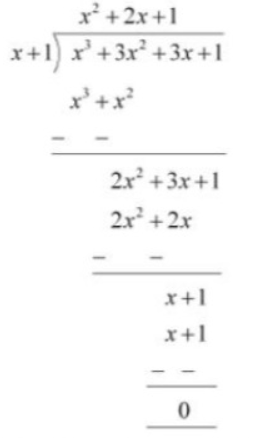
Therefore, remainder is .
Q1 (ii) Find the remainder when is divided by
Answer:
When we divide by
.
By long division method, we will get
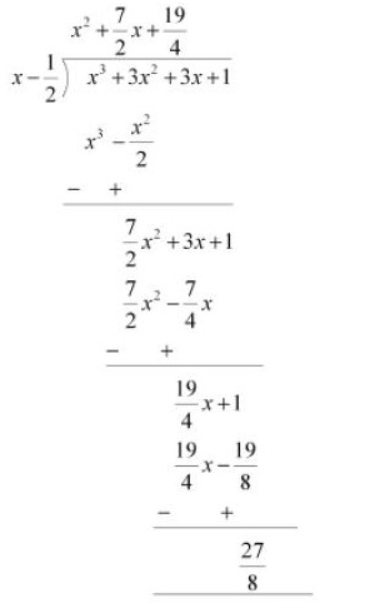 Therefore, the remainder is
Therefore, the remainder is
Q1 (iii) Find the remainder when is divided by
Answer:
When we divide by
.
By long division method, we will get

Therefore, remainder is .
Q1 (iv) Find the remainder when is divided by
Answer:
When we divide by
.
By long division method, we will get
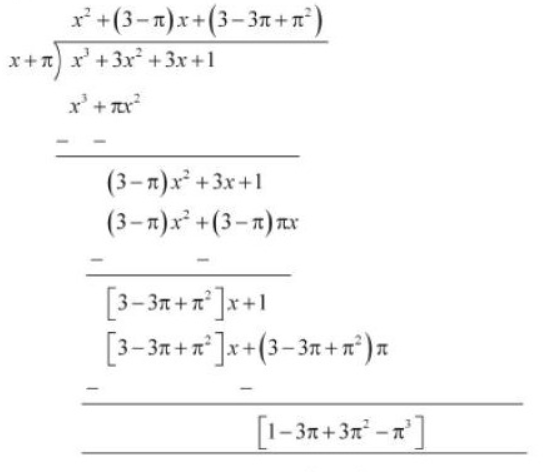
Therefore, the remainder is
Q1 (v) Find the remainder when is divided by
Answer:
When we divide by
.
By long division method, we will get
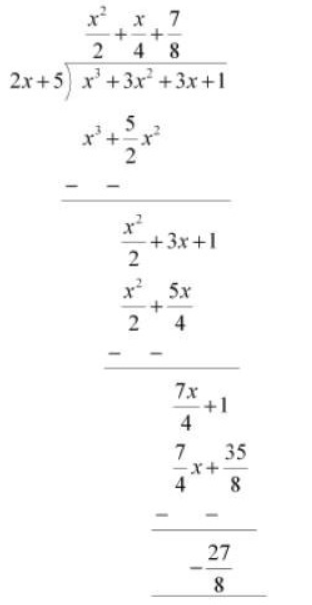
Therefore, the remainder is
Q2 Find the remainder when is divided by
.
Answer:
When we divide by
.
By long division method, we will get

Therefore, remainder is
Q3 Check whether is a factor of
Answer:
When we divide by
.
We can also write as
By long division method, we will get
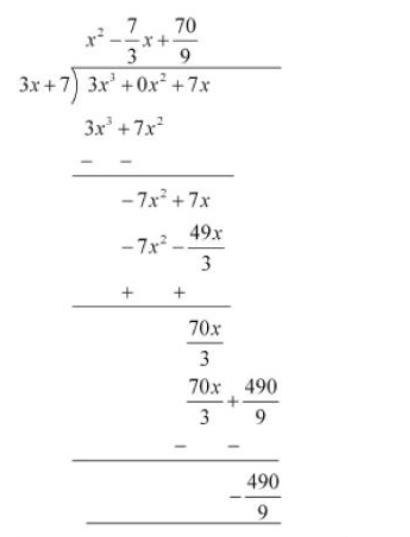
Since, remainder is not equal to 0
Therefore, is not a factor of
Class 9 polynomials NCERT solutions Exercise: 2.4
Q1 (i) Determine which of the following polynomials has a factor :
Answer:
Zero of polynomial is -1.
If is a factor of polynomial
Then, must be equal to zero
Now,
Therefore, is a factor of polynomial
Q1 (ii) Determine which of the following polynomials has a factor :
Answer:
Zero of polynomial is -1.
If is a factor of polynomial
Then, must be equal to zero
Now,
Therefore, is not a factor of polynomial
Q1 (iii) Determine which of the following polynomials has a factor :
Answer:
Zero of polynomial is -1.
If is a factor of polynomial
Then, must be equal to zero
Now,
Therefore, is not a factor of polynomial
Q1 (iv) Determine which of the following polynomials has a factor :
Answer:
Zero of polynomial is -1.
If is a factor of polynomial
Then, must be equal to zero
Now,
Therefore, is not a factor of polynomial
Q2 (i) Use the Factor Theorem to determine whether g(x) is a factor of p(x) in the following case:
Answer:
Zero of polynomial is
If is factor of polynomial
Then, must be equal to zero
Now,
Therefore, is factor of polynomial
Q2 (ii) Use the Factor Theorem to determine whether g(x) is a factor of p(x) in the following case:
Answer:
Zero of polynomial is
If is factor of polynomial
Then, must be equal to zero
Now,
Therefore, is not a factor of polynomial
Q2 (iii) Use the Factor Theorem to determine whether g(x) is a factor of p(x) in the following case:
Answer:
Zero of polynomial is
If is factor of polynomial
Then, must be equal to zero
Now,
Therefore, is a factor of polynomial
Q3 (i) Find the value of k , if is a factor of p(x) in the following case:
Answer:
Zero of polynomial is
If is factor of polynomial
Then, must be equal to zero
Now,
Therefore, value of k is
Q3 (ii) Find the value of k , if is a factor of p(x) in the following case:
Answer:
Zero of the polynomial is
If is factor of polynomial
Then, must be equal to zero
Now,
Therefore, value of k is
Q3 (iii) Find the value of k , if is a factor of p(x) in the following case:
Answer:
Zero of polynomial is
If is factor of polynomial
Then, must be equal to zero
Now,
Therefore, value of k is
Q3 (iv) the value of k , if is a factor of p(x) in the following case:
Answer:
Zero of polynomial is
If is factor of polynomial
Then, must be equal to zero
Now,
Therefore, value of k is
Q4 (i) Factorise :
Answer:
Given polynomial is
We need to factorise the middle term into two terms such that their product is equal to and their sum is equal to
We can solve it as
Q4 (ii) Factorise :
Answer:
Given polynomial is
We need to factorise the middle term into two terms such that their product is equal to and their sum is equal to
We can solve it as
Q4 (iii) Factorise :
Answer:
Given polynomial is
We need to factorise the middle term into two terms such that their product is equal to and their sum is equal to
We can solve it as
Q4 (iv) Factorise :
Answer:
Given polynomial is
We need to factorise the middle term into two terms such that their product is equal to and their sum is equal to
We can solve it as
Q5 (i) Factorise :
Answer:
Given polynomial is
Now, by hit and trial method we observed that is one of the factors of the given polynomial.
By long division method, we will get
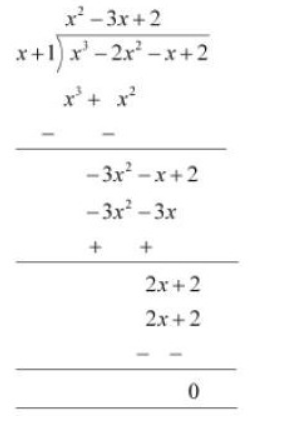 We know that Dividend = (Divisor × Quotient) + Remainder
We know that Dividend = (Divisor × Quotient) + Remainder
Therefore, on factorization of we will get
Q5 (ii) Factorise :
Answer:
Given polynomial is
Now, by hit and trial method we observed that is one of the factors of the given polynomial.
By long division method, we will get
 We know that Dividend = (Divisor
We know that Dividend = (Divisor Quotient) + Remainder
Therefore, on factorization of we will get
Q5 (iii) Factorise :
Answer:
Given polynomial is
Now, by hit and trial method we observed that is one of the factore of given polynomial.
By long division method, we will get
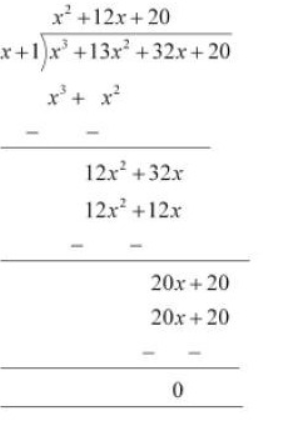 We know that Dividend = (Divisor
We know that Dividend = (Divisor Quotient) + Remainder
Therefore, on factorization of we will get
Q5 (iv) Factorise :
Answer:
Given polynomial is
Now, by hit and trial method we observed that is one of the factors of the given polynomial.
By long division method, we will get
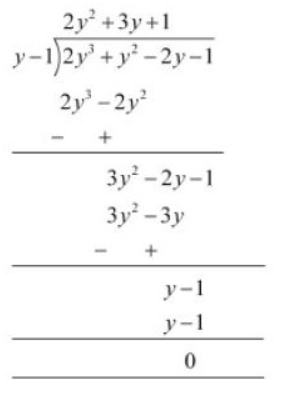 We know that Dividend = (Divisor
We know that Dividend = (Divisor Quotient) + Remainder
Therefore, on factorization of we will get
Class 9 maths chapter 2 question answer Exercise: 2.5
Q1 (i) Use suitable identities to find the following product:
Answer:
We will use identity
Put
Therefore, is equal to
Q1 (ii) Use suitable identities to find the following product:
Answer:
We will use identity
Put
Therefore, is equal to
Q1 (iii) Use suitable identities to find the following product:
Answer:
We can write as
We will use identity
Put
Therefore, is equal to
Q1 (iv) Use suitable identities to find the following product:
Answer:
We will use identity
Put
Therefore, is equal to
Q1 (v) Use suitable identities to find the following product:
Answer:
We can write as
We will use identity
Put
Therefore, is equal to
Q2 (i) Evaluate the following product without multiplying directly:
Answer:
We can rewrite as
We will use identity
Put
Therefore, value of is
Q2 (ii) Evaluate the following product without multiplying directly:
Answer:
We can rewrite as
We will use identity
Put
Therefore, value of is
Q2 (iii) Evaluate the following product without multiplying directly:
Answer:
We can rewrite as
We will use identity
Put
Therefore, value of is
Q3 (i) Factorise the following using appropriate identities:
Answer:
We can rewrite as
Using identity
Here,
Therefore,
Q3 (ii) Factorise the following using appropriate identities:
Answer:
We can rewrite as
Using identity
Here,
Therefore,
Q3 (iii) Factorise the following using appropriate identities:
Answer:
We can rewrite as
Using identity
Here,
Therefore,
Q4 (i) Expand each of the following, using suitable identities:
Answer:
Given is
We will Use identity
Here,
Therefore,
Q4 (ii) Expand each of the following, using suitable identities:
Answer:
Given is
We will Use identity
Here,
Therefore,
Q4 (iii) Expand each of the following, using suitable identities:
Answer:
Given is
We will Use identity
Here,
Therefore,
Q4 (iv) Expand each of the following, using suitable identities:
Answer:
Given is
We will Use identity
Here,
Therefore,
Q4 (v) Expand each of the following, using suitable identities:
Answer:
Given is
We will Use identity
Here,
Therefore,
Q4 (vi) Expand each of the following, using suitable identities:
Answer:
Given is
We will Use identity
Here,
Therefore,
Q6 (i) Write the following cubes in expanded form:
Answer:
Given is
We will use identity
Here,
Therefore,
Q6 (ii) Write the following cube in expanded form:
Answer:
Given is
We will use identity
Here,
Therefore,
Q6 (iii) Write the following cube in expanded form:
Answer:
Given is
We will use identity
Here,
Therefore,
Q6 (iv) Write the following cube in expanded form:
Answer:
Given is
We will use identity
Here,
Therefore,
Q7 (i) Evaluate the following using suitable identities:
Answer:
We can rewrite as
We will use identity
Here,
Therefore,
Q7 (ii) Evaluate the following using suitable identities:
Answer:
We can rewrite as
We will use identity
Here,
Therefore,
Q7 (iii) Evaluate the following using suitable identities:
Answer:
We can rewrite as
We will use identity
Here,
Therefore,
Q14 (i) Without actually calculating the cubes, find the value of each of the following:
Answer:
Given is
We know that
If then ,
Here,
Therefore,
Therefore, value of is
Q14 (ii) Without actually calculating the cubes, find the value of the following:
Answer:
Given is
We know that
If then ,
Here,
Therefore,
Therefore, value of is
Answer:
We know that
Area of rectangle is =
It is given that area =
Now, by splitting middle term method
Therefore, two answers are possible
case (i) :- Length = and Breadth =
case (ii) :- Length = and Breadth =
Answer:
We know that
Area of rectangle is =
It is given that area =
Now, by splitting the middle term method
Therefore, two answers are possible
case (i) :- Length = and Breadth =
case (ii) :- Length = and Breadth =
Q16 (i) What are the possible expressions for the dimensions of the cuboid whose volumes is given below?
Volume : |
Answer:
We know that
Volume of cuboid is =
It is given that volume =
Now,
Therefore,one of the possible answer is possible
Length = and Breadth =
and Height =
Q16 (ii) What are the possible expressions for the dimensions of the cuboid whose volumes is given below?
Volume : |
Answer:
We know that
Volume of cuboid is =
It is given that volume =
Now,
Therefore,one of the possible answer is possible
Length = and Breadth =
and Height =
It is an important topic in maths that comes under the algebra unit which holds 20 marks in the CBSE Class 9 Maths final exams. In this particular NCERT textbook chapter, you will study the definition of a polynomial, zeroes, coefficient, degrees, and terms of a polynomial, type of a polynomial. You will also study the remainder and factor theorems and the factorization of polynomials. In Polynomials, there are a total of 5 exercises that comprise of a total of 33 questions. NCERT solutions for Class 9 Maths chapter 2 Polynomials will cover the detailed solution to each and every question present in the practice exercises including optional exercises.
Interested students can practice class 9 maths ch 2 question answer using the following exercises.
Chapter No. | Chapter Name |
Chapter 1 | |
Chapter 2 | Polynomials |
Chapter 3 | |
Chapter 4 | |
Chapter 5 | |
Chapter 6 | |
Chapter 7 | |
Chapter 8 | |
Chapter 9 | |
Chapter 10 | |
Chapter 11 | |
Chapter 12 | |
Chapter 13 | |
Chapter 14 | |
Chapter 15 |
The class 9 chapter 2 maths solutions are prepared by experts at Careers360 who have extensive knowledge and experience in Mathematics.
Keep Working Hard and Happy Learning!
The NCERT class 9 maths chapter 2 includes topics such as definition of a polynomial, zeroes, coefficient, degrees, and terms of a polynomial, different types of a polynomial, remainder and factor theorems, and the factorization of polynomials. students should practice these NCERT solutions to get indepth understanding of these concepts which ultimately lead to score well in the exam.
Maths chapter 2 includes five exercises covering topics such as Polynomials in one variable, Zeros of a Polynomial, Real Numbers and their Decimal Expansions, Representing Real Numbers on the Number Line, Operations on Real Numbers, and Laws of Exponents for Real Numbers. Practicing these exercises of NCERT maths class 9 chapter 2 is crucial for achieving a better understanding of the concepts and scoring well in Mathematics. To help students gain confidence, Careers360 experts have designed these solutions to provide comprehensive explanations of the concepts covered in this chapter.
NCERT Solutions for Class 9 Maths Chapter 2 use straightforward language to explain the concepts, making it accessible even for students who struggle with Mathematics. These solutions are meticulously crafted by a team of experts at Careers360 with the objective of helping students prepare for their CBSE exams effectively.
Regular practice with NCERT Solutions for Class 9 Maths Chapter 2 can enable students to excel in their CBSE exams. These solutions are created by a team of skilled Maths experts at Careers360, and by solving all the questions and comparing their answers with the solutions, students can aim for high scores in their exams.
Here, students can get detailed NCERT solutions for Class 9 Maths which includes solutions to all the exercise of each chapters.
Late Fee Application Date:22 July,2024 - 31 July,2024
Late Fee Application Date:22 July,2024 - 31 July,2024

Register for Tallentex '25 - One of The Biggest Talent Encouragement Exam

Get up to 90% scholarship on NEET, JEE & Foundation courses

As per latest 2024 syllabus. Chemistry formulas, equations, & laws of class 11 & 12th chapters

As per latest 2024 syllabus. Physics formulas, equations, & laws of class 11 & 12th chapters

Accepted by more than 11,000 universities in over 150 countries worldwide

Register now for PTE & Save 5% on English Proficiency Tests with ApplyShop Gift Cards